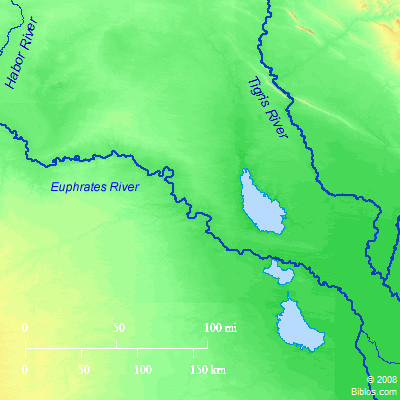Atlas  Tigris-Euphrates Region and surrounding area Maps Created using Biblemapper 3.0 Additional data from OpenBible.info You are free to use up to 50 Biblos coprighted maps (small or large) for your website or presentation. Please credit Biblos.com. Occurrences Genesis 1:1 In the beginning God created the heavens and the earth.Genesis 2:14 The name of the third river is Hiddekel: this is the one which flows in front of Assyria. The fourth river is the Euphrates. Genesis 3:23 Therefore Yahweh God sent him forth from the garden of Eden, to till the ground from which he was taken. Genesis 3:24 So he drove out the man; and he placed Cherubs at the east of the garden of Eden, and the flame of a sword which turned every way, to guard the way to the tree of life. Genesis 4:16 Cain went out from Yahweh's presence, and lived in the land of Nod, east of Eden. 2 Kings 19:12 Have the gods of the nations delivered them, which my fathers have destroyed, Gozan, and Haran, and Rezeph, and the children of Eden that were in Telassar? Isaiah 37:12 Have the gods of the nations delivered them, which my fathers have destroyed, Gozan, Haran, Rezeph, and the children of Eden who were in Telassar? Isaiah 51:3 For Yahweh has comforted Zion; he has comforted all her waste places, and has made her wilderness like Eden, and her desert like the garden of Yahweh; joy and gladness shall be found therein, thanksgiving, and the voice of melody. Ezekiel 27:23 Haran and Canneh and Eden, the traffickers of Sheba, Asshur and Chilmad, were your traffickers. Ezekiel 28:13 You were in Eden, the garden of God; every precious stone adorned you: ruby, topaz, emerald, chrysolite, onyx, jasper, sapphire, turquoise, and beryl. Gold work of tambourines and of pipes was in you. In the day that you were created they were prepared. Ezekiel 31:9 I made it beautiful by the multitude of its branches, so that all the trees of Eden, that were in the garden of God, envied it. Ezekiel 31:16 I made the nations to shake at the sound of his fall, when I cast him down to Sheol with those who descend into the pit; and all the trees of Eden, the choice and best of Lebanon, all that drink water, were comforted in the lower parts of the earth. Ezekiel 31:18 To whom are you thus like in glory and in greatness among the trees of Eden? yet you will be brought down with the trees of Eden to the lower parts of the earth: you shall lie in the midst of the uncircumcised, with those who are slain by the sword. This is Pharaoh and all his multitude, says the Lord Yahweh. Ezekiel 36:35 They shall say, This land that was desolate is become like the garden of Eden; and the waste and desolate and ruined cities are fortified and inhabited. Joel 2:3 A fire devours before them, and behind them, a flame burns. The land is as the garden of Eden before them, and behind them, a desolate wilderness. Yes, and no one has escaped them. Encyclopedia TIGRISti'-gris (Tigris, the Greek equivalent of the Hebrew chiddeqel): One of the rivers of Eden going "eastward to Assyria" (Genesis 2:14 margin), called the Great River (Daniel 10:4), elsewhere mentioned in the apocryphal books, as in Tob 6:1; Judith 1:6; Ecclesiasticus 24:25, called Diglath in Josephus, and Diglit in Pliny, now called in Mesopotamia Dijleh, generally supposed to be a Semitic corruption of Tigra, meaning originally an arrow, which from its rapidity of motion is symbolized. The Tigris rises in the mountains of Armenia, latitude 38 degrees 10 minutes, longitude 39 degrees 20 minutes, only a few miles from the main branch of the Euphrates. After pursuing a tortuous southeasterly course for 150 miles, it is joined by the east branch at Osman Kieui, some distance below Diarbekr. Here the stream is 450 ft. wide and 3 or 4 ft. deep. Passing through numerous mountain gorges for another 150 miles, it emerges into the region of low hills about Nineveh, and a little below into the great alluvial plain of Mesopotamia. Thence in its course to Bagdad it is joined by the Great Zab, the Lesser Zab, the Adhem, and the Diyaleh rivers, bringing a large amount of water from the Zagros Mountains. At Bagdad the overflows from the Euphrates in high water often increase the inundations. The flood season begins early in the month of March, reaching its climax about May 1, declining to its natural level by midsummer. In October and November, the volume of water increases considerably, but not so much as to overflow its banks. Below Bagdad, throughout the region of Babylonia proper, the Tigris joins with the Euphrates in furnishing the water for irrigation so successfully used in ancient times. English engineers are at present with great promise of success aiming to restore the irrigating systems of the region and the prosperity of ancient times. The total length of the river is 1,146 miles. It now joins the Euphrates about 40 miles Northwest of the Persian Gulf, the two streams there forming the Shat el Arab, but in early historical times they entered the Persian Gulf by separate mouths, the Gulf then extending a considerable distance above the present junction of the rivers, the sediment of the streams having silted up the head of the Gulf to that distance. |



